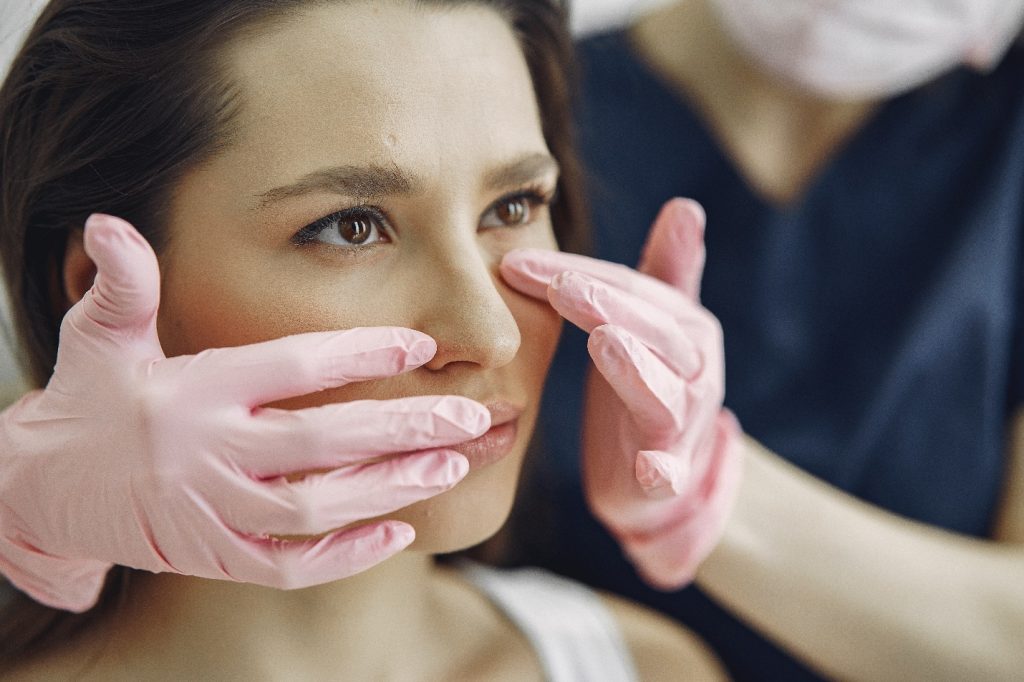Frequently Asked Questions in Rhinoplasty

Table of Contents
1.What is rhinoplasty?
Rhinoplasty, commonly known as a nose job, is a surgical procedure designed to reshape or correct the nasal structure. While frequently sought for aesthetic reasons, rhinoplasty can also be performed for medical purposes, such as addressing breathing issues or congenital deformities. This transformative surgery involves careful adjustments to achieve a harmonious balance between facial features, providing individuals with not only a physical change but often a boost in self-confidence. Surgeons employ their expertise to sculpt the nose, considering both the patient’s desired outcome and the anatomical nuances of their unique facial characteristics. Whether undertaken for cosmetic enhancement or functional improvement, rhinoplasty remains a nuanced and personalized medical procedure.
2.My nose is too big. Can you make it smaller?
Feeling self-conscious about the size of one’s nose is a common sentiment, and the prospect of altering it through rhinoplasty often arises as a solution. The desire for a smaller nose is a personal choice, driven by individual perceptions of beauty and self-image. In the realm of plastic surgery, a skilled surgeon can indeed help reshape and reduce the size of the nose, bringing it into better proportion with the rest of the facial features. This procedure, known as rhinoplasty, involves careful consideration of the patient’s unique facial anatomy and their aesthetic preferences. It’s not just about making the nose smaller; it’s about achieving a balanced and natural result that aligns with the individual’s overall facial harmony. The decision to undergo such a transformative journey is deeply personal, and the skilled hands of a surgeon work to bring about a change that not only meets physical expectations but also contributes to a sense of confidence and self-assurance.
3.What is a standard rhinoplasty?
A standard rhinoplasty, often referred to as a nose job, is a surgical procedure aimed at modifying the shape and structure of the nose to enhance both its aesthetic appearance and functionality. This popular cosmetic surgery can address various concerns, including the size, shape, and symmetry of the nose. During a standard rhinoplasty, a skilled surgeon may make adjustments to the nasal bones, cartilage, and tissues, sculpting the nose to achieve a more balanced and harmonious look in relation to the rest of the face. Beyond the cosmetic aspect, rhinoplasty can also correct breathing issues or congenital abnormalities that affect nasal function. The procedure is highly personalized, with the surgeon working closely with the patient to understand their goals and expectations. A successful standard rhinoplasty not only transforms the physical characteristics of the nose but also boosts the individual’s confidence and satisfaction with their overall appearance.
4.Is rhinoplasty cosmetic or reconstructive?
The classification of rhinoplasty as either cosmetic or reconstructive depends on the primary purpose of the surgery. In essence, rhinoplasty straddles the realms of both. When performed for aesthetic reasons, it falls under the category of cosmetic surgery, as individuals seek to enhance the appearance of their nose for reasons of personal satisfaction or cultural ideals. On the other hand, rhinoplasty can also be deemed reconstructive when the procedure is undertaken to correct functional issues, repair trauma-related injuries, or address congenital anomalies affecting the nasal structure. The versatility of rhinoplasty, spanning both cosmetic and reconstructive objectives, underscores its dual role in not only refining the external aesthetics of the nose but also improving its internal functionality. Ultimately, the distinction between cosmetic and reconstructive rhinoplasty is blurred, highlighting the nuanced and individualized nature of this transformative surgical procedure.
5.What is the difference between “open” and “closed” rhinoplasty?
The key distinction between “open” and “closed” rhinoplasty lies in the approach taken by surgeons during the procedure. In a closed rhinoplasty, incisions are confined to the inside of the nose, hidden from external view. This method is often preferred for minor adjustments, as it minimizes visible scarring and generally results in a quicker recovery. On the other hand, an open rhinoplasty involves an additional small incision made across the columella, the strip of tissue between the nostrils, providing the surgeon with a more direct view and access to the nasal structures. While this technique may leave a tiny scar, it is especially beneficial for complex cases where extensive changes or detailed work is required. Choosing between open and closed rhinoplasty depends on the individual’s unique needs, the complexity of the procedure, and the surgeon’s preference. Both approaches aim to achieve a harmonious and natural result, demonstrating the artistry and precision involved in the practice of rhinoplasty.
6.Is it possible to have a rhinoplasty without haveing that unnatural of “operated” look?
Absolutely, it’s entirely possible to undergo rhinoplasty without ending up with that telltale “operated” appearance. Skilled surgeons today prioritize achieving natural-looking results that seamlessly blend with a person’s unique facial features. The key lies in the surgeon’s expertise and their ability to understand the nuances of facial harmony. A successful rhinoplasty involves subtle adjustments that enhance the nose while preserving its natural character. Communication between the patient and the surgeon is crucial, as it allows for a clear understanding of the individual’s aesthetic goals. Modern techniques, such as precision sculpting and a personalized approach to each procedure, contribute to more natural outcomes. The aim is not to erase the uniqueness of one’s features but rather to create a balanced and harmonious look that boosts confidence without betraying the authenticity of the person’s appearance. With advancements in surgical methods and a focus on individualized results, it’s increasingly common for individuals to achieve a refined and natural look through rhinoplasty.
7. Can you improve the breathing through my nose?
Certainly, improving nasal breathing is a common and valid concern that often prompts individuals to consider rhinoplasty. Beyond its cosmetic benefits, rhinoplasty can be a transformative solution for those struggling with breathing issues. Skilled surgeons approach this aspect of rhinoplasty with precision, aiming to enhance both the aesthetic and functional aspects of the nose. Adjustments may involve reshaping the nasal passages, correcting deviated septums, or addressing other structural impediments that contribute to restricted airflow. This dual-purpose approach underscores the versatility of rhinoplasty, highlighting its potential to not only refine the external appearance of the nose but also to significantly improve its functionality. The collaborative process between patient and surgeon plays a pivotal role in achieving these outcomes, ensuring that the individual’s concerns about breathing are addressed while achieving a harmonious and natural-looking result.
8. Do I have to stay overnight at the hospital after surgery?
The duration of your hospital stay after rhinoplasty depends on various factors, including the complexity of the procedure and your surgeon’s recommendations. In many cases, rhinoplasty is performed as an outpatient procedure, allowing you to return home on the same day. Advances in surgical techniques and anesthesia have made it possible for patients to recover comfortably at home. However, if your surgeon advises or if there are specific medical considerations, an overnight stay may be recommended. This decision is made with your well-being in mind, ensuring that you receive the necessary post-operative care and monitoring. Regardless of the length of your hospital stay, a smooth recovery is typically supported by following your surgeon’s post-operative instructions diligently, which may include rest, elevation of the head, and regular follow-up appointments to track your progress.
9. What kind of anesthesia is used for surgery?
The choice of anesthesia for rhinoplasty depends on several factors, including the complexity of the procedure, the surgeon’s preference, and your medical history. Generally, rhinoplasty can be performed under either local anesthesia with sedation or general anesthesia. Local anesthesia with sedation involves numbing the specific area around the nose while keeping you relaxed and comfortable. It allows for a faster recovery and is often suitable for less invasive procedures. On the other hand, general anesthesia ensures that you are completely unconscious during the surgery. This is typically recommended for more extensive or complex rhinoplasties. Your surgeon and anesthesia team will carefully consider your individual health factors and the nature of the surgery to determine the most suitable option. Their primary goal is to ensure your safety, comfort, and a smooth surgical experience. If you have concerns or preferences regarding anesthesia, discussing them openly with your surgical team beforehand can help address any questions and ensure that you feel confident about the choices made for your procedure.
10. How long does rhinoplasty take?
The duration of a rhinoplasty procedure can vary based on several factors, including the complexity of the surgery and the specific alterations being made. On average, rhinoplasty typically takes around two to three hours to complete. However, more intricate cases or those involving both aesthetic and functional adjustments may require additional time. Your surgeon will provide a more accurate estimate during the pre-operative consultation, considering factors such as the extent of nasal reshaping, the need for grafts or structural modifications, and the overall surgical approach. While the surgery itself may take a few hours, the entire process, including pre-operative preparations and post-operative recovery in the clinic, will extend the time spent at the medical facility. It’s essential to prioritize a thorough consultation with your surgeon to discuss the specifics of your case and gain a clearer understanding of the anticipated duration and recovery process tailored to your unique needs.
11. Will there be any nasal packing?
The use of nasal packing after rhinoplasty varies among surgeons and the specifics of each case. Traditionally, nasal packing—small dressings or soft material placed inside the nose—was a common practice to control bleeding and support the healing process. However, many modern rhinoplasty techniques aim to minimize discomfort for patients, and nasal packing is not universally employed. Some surgeons prefer to use absorbable sutures and other methods to achieve hemostasis without the need for extensive packing. If your surgeon does opt for nasal packing, it is typically removed within a few days after the procedure. While nasal packing can be associated with temporary discomfort, advancements in surgical techniques have allowed for more individualized and patient-friendly approaches. It’s essential to discuss this aspect with your surgeon during the pre-operative consultations to understand their specific practices and what to expect in terms of post-operative care and comfort.
13. What is recovery like?
The recovery process after rhinoplasty is a unique and individual experience, varying from person to person. In the initial days following the surgery, it’s common to experience some swelling and bruising around the nose and eyes. Most patients find that these effects gradually subside within the first week or two. Pain and discomfort are typically manageable with prescribed medications, and many individuals can resume normal activities within a week, although strenuous exercise should be avoided for a bit longer. While the majority of the swelling resolves in the first few weeks, subtle changes may continue for several months. It’s essential to follow your surgeon’s post-operative instructions diligently, which may include keeping the head elevated, avoiding certain activities, and attending follow-up appointments to monitor progress. Patience is key during the recovery period, as the final results of rhinoplasty may take some time to fully reveal themselves. Open communication with your surgical team and adherence to post-operative care guidelines contribute to a smoother and more satisfying recovery journey.
14. Will I have bruising after surgery?
The likelihood of experiencing bruising after rhinoplasty can vary from person to person. Bruising is a common side effect, especially in the initial days following the surgery. Factors such as individual susceptibility, the extent of the procedure, and surgical techniques can influence the degree of bruising. While some individuals may notice minimal or no bruising at all, others might experience more pronounced discoloration around the eyes and nose. Fortunately, bruising is usually temporary and tends to diminish within the first week or two of the recovery period. Applying cold compresses and following your surgeon’s post-operative care instructions, including any prescribed medications, can help minimize bruising and swelling. It’s important to discuss this aspect with your surgeon during pre-operative consultations to gain a personalized understanding of what to expect based on your specific case and to ensure you are well-prepared for the recovery journey.
15. Will insurance cover my surgery?
The coverage of rhinoplasty by insurance largely depends on the nature of the procedure. Generally, if the surgery is performed for cosmetic reasons to enhance appearance without addressing specific medical issues, insurance is unlikely to cover the costs. However, if the rhinoplasty has a reconstructive or functional component, such as correcting a deviated septum or addressing breathing difficulties, there may be a possibility of insurance coverage. It’s crucial to thoroughly review your insurance policy and discuss the specifics with your surgeon. They can provide detailed documentation and justification for the medical necessity of the procedure, potentially increasing the chances of insurance coverage. Clear communication with both your surgeon and insurance provider is key to understanding the financial aspects of your rhinoplasty, ensuring that you are well-informed about potential costs and coverage before proceeding with the surgery.
16. I have had a rhinoplasty before and I am unhappy with my result. Can this be fixed?
Feeling dissatisfied with the results of a previous rhinoplasty is not uncommon, and the good news is that corrective measures are often possible. Revision rhinoplasty is a specialized procedure designed to address issues or refine the outcomes of a previous nose surgery. Whether the concerns involve asymmetry, breathing difficulties, or an overall dissatisfaction with the appearance, a skilled and experienced surgeon can work with you to understand your specific concerns and formulate a tailored plan for improvement. It’s crucial to have open and honest communication with your surgeon about your expectations and the areas you wish to address. Revision rhinoplasty demands a meticulous approach, taking into account the existing anatomy and the changes desired. While it may involve additional challenges compared to a primary rhinoplasty, the goal is to achieve a more satisfying and harmonious result, restoring your confidence in the appearance and function of your nose.
17. Can I have other cosmetic surgery at the same time as my rhinoplasty?
Combining other cosmetic procedures with rhinoplasty is indeed a common practice and is often referred to as a combination or simultaneous surgery. Many individuals choose to address multiple cosmetic concerns in one session, streamlining the overall process and minimizing the downtime associated with separate surgeries. Popular combinations include facelifts, eyelid surgery, or chin augmentation, depending on the individual’s goals and the surgeon’s recommendations. While the prospect of addressing multiple areas at once can be appealing, it’s crucial to consider factors such as overall health, recovery expectations, and the potential impact on results. Your surgeon will assess your candidacy for combined procedures during the consultation, ensuring that the combination is safe and aligns with your aesthetic objectives. The personalized approach taken in these situations reflects the collaborative effort between the patient and the surgeon to achieve comprehensive and harmonious results.
18. Why do surgeons sometimes move the chin forward or place a chin implant during rhinoplasty surgery?
Surgeons may opt to move the chin forward or incorporate a chin implant during rhinoplasty surgery for several strategic reasons. The relationship between the nose and the chin significantly influences facial harmony and balance. In cases where the chin is recessed or lacks definition, adjusting its position or introducing an implant can enhance the overall facial profile. By addressing both the nose and the chin simultaneously, surgeons aim to create a more harmonious and proportionate appearance. This combined approach ensures that changes made to the nose complement the entire facial structure. Additionally, enhancing the chin’s prominence can draw attention to the middle of the face, providing a more aesthetically pleasing result. The decision to include chin augmentation in rhinoplasty is made on a case-by-case basis, considering the patient’s unique facial features and their desired outcome. The collaborative effort between the surgeon and the patient aims to achieve comprehensive and natural-looking results that enhance overall facial balance.







